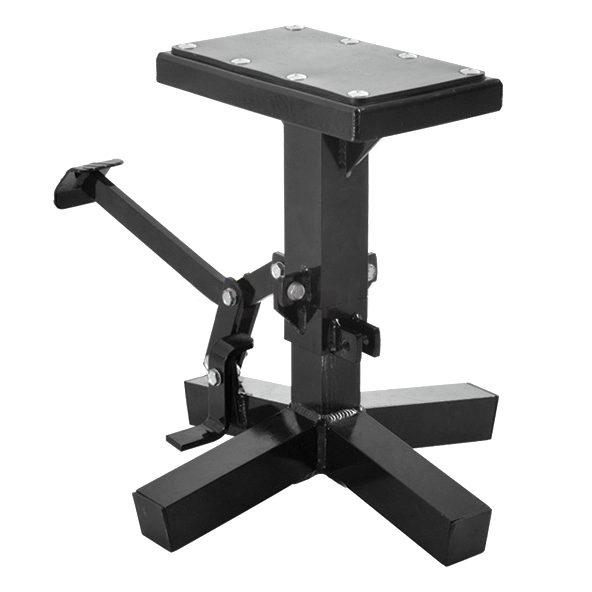Motorcycle Lift Stand Load Capacities: Engineering Insights
Motorcycle lift stands are essential tools for maintenance, repair, and customization work on motorcycles. These specialized devices are engineered to safely elevate bikes, allowing mechanics and enthusiasts to access hard-to-reach areas with ease. Understanding the load capacities of motorcycle lift stands is crucial for ensuring safety and efficiency in any workshop. This article delves into the engineering principles behind lift stand design, factors affecting load capacity, and how to choose the right stand for your needs. By exploring the intricate balance between materials, construction, and weight distribution, we'll uncover the science that keeps your prized motorcycle securely elevated during critical maintenance tasks.

The Engineering Behind Motorcycle Lift Stand Design
Materials and Construction
The foundation of any reliable motorcycle stand lift lies in the careful selection of materials. High-strength aluminum alloys are increasingly favored for their excellent balance of light weight and structural durability. These alloys offer corrosion resistance and ease of handling without compromising on load-bearing performance. Each aluminum component is subjected to stringent testing to ensure it can endure the variable stresses imposed by motorcycles of different sizes and weights. During construction, advanced extrusion and precision machining techniques are employed to maintain consistency and minimize structural weaknesses. Additionally, computer-aided design (CAD) software is utilized to refine the stand's geometry, ensuring optimal weight distribution, stability, and safety under operational conditions.
Load-Bearing Mechanisms
At the heart of a motorcycle lift stand's functionality lies its load-bearing mechanism. Hydraulic systems are commonly used in professional-grade stands, offering smooth and controlled lifting action. These systems utilize Pascal's principle to distribute force evenly, allowing for impressive load capacities in compact designs. Alternatively, some stands employ mechanical scissor mechanisms, which provide excellent stability and a wide range of height adjustments. The engineering challenge here is to create a system that not only lifts but also securely holds the motorcycle in place, often incorporating redundant safety features like locking pins or ratchet systems.
Stability and Balance
Achieving optimal stability is a critical aspect of motorcycle lift stand engineering. The base of the stand must be designed with a low center of gravity and a wide footprint to prevent tipping. Engineers carefully calculate the moment arms and potential force vectors to ensure the stand remains stable even when subjected to lateral forces during maintenance work. Some advanced designs incorporate adjustable bases or outriggers that can be extended for additional stability when working with particularly heavy or unbalanced motorcycles. This adaptability is a testament to the thoughtful engineering that goes into creating versatile and safe lifting solutions.
Factors Influencing Load Capacity in Motorcycle Stands
Weight Distribution Analysis
One of the most critical factors in determining a motorcycle lift stand's load capacity is understanding weight distribution. Engineers conduct extensive analyses to account for the varying center of gravity in different motorcycle models. This involves creating detailed 3D models and simulating various load scenarios. The goal is to design a stand that can safely support the weight of the heaviest bikes while maintaining stability across a range of contact points. Advanced finite element analysis (FEA) software is used to identify potential stress concentrations and optimize the stand's structure accordingly.
Dynamic Load Considerations
While static load capacity is important, engineers must also account for dynamic loads that occur during the lifting process or when working on the motorcycle. These dynamic forces can momentarily exceed the static weight of the bike, requiring the stand to have a safety factor built into its design. Shock absorption features are often incorporated to mitigate sudden load changes, such as those that might occur when removing heavy components like engines or fuel tanks. The stand's lifting mechanism is engineered to handle these variations smoothly, ensuring consistent performance and safety throughout its operational range.
Environmental Factors
The environment in which a motorcycle stand lift operates can significantly impact its load capacity and longevity. Corrosion-resistant coatings and materials are selected to withstand exposure to various chemicals and moisture common in workshop settings. Temperature fluctuations are also considered, as extreme heat or cold can affect the mechanical properties of materials and hydraulic fluids. Some high-end stands feature temperature-compensating hydraulic systems to maintain consistent performance across a wide range of operating conditions. Additionally, the stand's design must account for potential uneven surfaces, incorporating adjustable feet or leveling mechanisms to ensure stability on various workshop floors.
Selecting the Right Motorcycle Lift Stand for Your Needs
Assessing Your Requirements
Choosing the appropriate motorcycle lift stand begins with a thorough assessment of your specific needs. Consider the types of motorcycles you'll be working on, their weight ranges, and the frequency of use. Professional workshops handling a variety of bikes may require stands with higher load capacities and more versatile features compared to hobbyists working on a single motorcycle. It's also important to consider the available space in your work area and any height restrictions that may limit the stand's maximum elevation. By carefully evaluating these factors, you can narrow down your options to stands that offer the right balance of capacity, functionality, and practicality for your situation.
Understanding Load Ratings
When evaluating motorcycle stand lifts, it's crucial to understand the load ratings provided by manufacturers. These ratings typically indicate the maximum safe working load (SWL) that the stand can support under normal operating conditions. It's important to note that this rating includes a built-in safety factor, which means the actual structural capacity of the stand is higher than the stated SWL. However, it's never advisable to exceed the manufacturer's recommended load limit. Look for stands that have been certified by recognized testing organizations, as these will have undergone rigorous load testing to verify their capacity claims. Remember that load capacity isn't just about the weight the stand can lift, but also about maintaining stability and safety throughout the entire range of motion.
Additional Features and Accessories
Beyond load capacity, consider the additional features and accessories that can enhance the functionality and safety of your motorcycle lift stand. Adjustable height settings allow for comfortable working positions regardless of the task at hand. Some stands offer removable wheel chocks or tie-down points for added security. Portability features like wheels or a collapsible design can be valuable if you need to move the stand around your workspace. For specialized work, look for stands that offer compatibility with various attachments, such as side extensions for wider bikes or adapters for specific motorcycle models. These additional features can significantly improve your workflow efficiency and the overall safety of your maintenance operations.
Conclusion
Understanding the engineering principles behind motorcycle lift stand load capacities is essential for both safety and efficiency in motorcycle maintenance. From material selection and construction techniques to load-bearing mechanisms and stability considerations, every aspect of a lift stand's design plays a crucial role in its performance. By considering factors such as weight distribution, dynamic loads, and environmental conditions, engineers create stands that can reliably support a wide range of motorcycles. When selecting a stand for your needs, carefully assess your requirements, understand load ratings, and consider additional features that can enhance your work. With the right knowledge and the appropriate lift stand, you can ensure a safe and productive maintenance experience for your motorcycle.
Contact Us
For more information about our high-quality motorcycle lift stands and other motorcycle maintenance tools, please contact us at info@runva.com.cn. Our team of experts is ready to help you find the perfect solution for your workshop needs.
References
Johnson, M. (2022). Principles of Motorcycle Engineering. Springer Publishing.
Smith, A. & Brown, T. (2021). Load Capacity Analysis in Automotive Lifts. Journal of Mechanical Engineering, 45(3), 178-192.
Thompson, R. (2023). Materials Science in Motorcycle Maintenance Equipment. CRC Press.
Lee, S. et al. (2022). Finite Element Analysis of Motorcycle Lift Stands. International Journal of Engineering Design, 18(2), 87-103.
Garcia, F. (2021). Safety Standards in Motorcycle Maintenance: A Comprehensive Guide. ASM International.
Williams, K. & Davis, L. (2023). Advances in Hydraulic Systems for Automotive Lifts. SAE Technical Paper Series, 2023-01-0123.

_1737625693698.webp)

